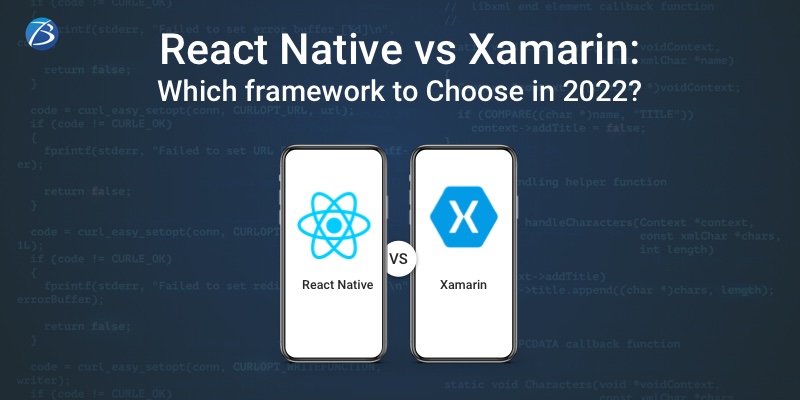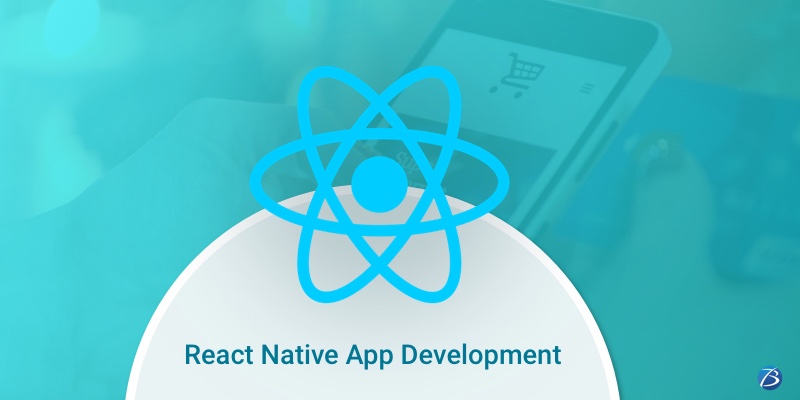React Native or Xamarin: Which framework should you Pick in 2022?


Modern-era applications are required to run seamlessly on Android and iOS – the two major operating systems. Needless to say, most entrepreneurs prefer cross-platform app development to stay competitive; and at the same time aim at offering outstanding UX at reduced development costs. Two of the most popular frameworks leveraged for crafting cross-platform apps are React Native and Xamarin. Now, the million-dollar question is; ‘Which framework outshines the other?’
Well, this post compares the offerings of both these frameworks and guides you through picking the right one that best suits your app development requirements. Let’s explore!
React Native and Xamarin: An Overview
The React Native framework was coined by Facebook and launched in March 2015. This open-source app development technology has been leveraged by biggies like Uber, Tesla, Facebook, Walmart, Skype, Bloomberg, and Vogue to create success stories.
Xamarin, the brainchild of Novell, came into being in 2011 and was taken over by Microsoft in 2016. This framework has been adopted by high-end firms and brands such as Cognizant, Honeywell, Cinemark, 3M, Alaska Airlines, Pinterest, YouTube etc.
React Native vs Xamarin: Analyzing the Differences and Distinct Offerings

Let’s dig into the major differences between React Native and Xamarin based on the following parameters and analyze what each of these outstanding cross-platform frameworks has to offer.
Development Environment (IDE)
The React Native development eco-system promises a substantial amount of flexibility and adaptability. This is because, developers need to install Node and choose any text editor or IDE they are comfortable working on, from a host of options available and accessible on the internet – Vim Editor, Visual Studio Code, Atom, Nuclide, Sublime Text, GNU Emacs Editor, TextMate Editor, Spacemace Editor, Deco IDE, etc. Besides, the hot reloading feature allows React Native developers to instantly reload the application without having to compile it and view the impact of the code changes live in real-time, thereby speeding up the app development process.
The Xamarin app development environment offers one single choice – developers are required to work in Visual Studio. Developers need to download and install Microsoft Visual Studio or the Visual Studio Community Edition; along with Mac. This developer environment comes with an IDE, a host of handy development tools, designs, and controls to ease out the app development process and make it faster. Additionally, utilizing Xamarin and NuGet plugins can further simplify development.
Inference: React Native development environment offers more flexibility than Xamarin.
Market Trends: Popularity
As per the stack overflow survey, React Native is placed in the 6th position in terms of popularity whereas Xamarin has bagged the 8th position. Besides, React Native enjoys 52013 stars and 12207 forks on GitHub, while Xamarin doesn’t appear in GitHub altogether. React Native has elaborate tooling, large community support and a large talent pool. Also since React Native is open-source, it is more popular than Xamarin.
Inference: React Native is more popular and widely adopted globally as compared to Xamarin.
App Development Cost
Most open-source frameworks including React Native are free, but this is not the case for Xamarin. Xamarin has a free version, but with limited features and so, it usually suits the need of individuals or small-sized businesses. In most cases, the paid version is needed and the cost of obtaining a Visual Studio Annual Edition is approximately $3000. Contrarily, React Native is not only free but also allows developers to pick the IDE as per their choice. Thus, React Native is immensely cost-efficient.
Inference: React Native app development projects involve more flexibility to developers and reduced developmental expenses as compared to Xamarin projects.
Testing Abilities
Both React Native and Xamarin offer adequate testing tools. However, the React Native framework offers easily configurable tools such as Jest, PropTypes, etc., the opportunity of creating Snapshot testing, and a rich API behavior. For this reason, the testing process becomes easier with React native and the chances of regressions in the code are ruled out completely.
Inference: React Native outperforms Xamarin.
Architecture and Working Principles
Xamarin uses the MVVM (Model View-View Model) architecture clubbed with a two-way data binding approach that allows collaboration between divisions. It is highly recommended for an app development project wherein it is not known whether the developmental cycle follows a performance-suited approach or not. The reason is this architecture offers flexibility and enables developers to obtain the desired outcome within a short time.
React Native, too, possess a modular architecture that allows developers to separate the code into independent functional blocks. The data binding, in this case, is uni-directional that enables working on the app’s generic performance. React Native also supports manual data binding and this trait helps in minimizing complex errors.
Inference: It’s a win- win situation for both the frameworks!
Documentation
React Native provides comprehensive documentation that is accurate and well-organized too; such that developers can effortlessly find the required elements and use them productively.
Xamarin offers comprehensive documentation too. But, this documentation is less useful because accessing it becomes hassle-prone as well as time-consuming due to the segregation of components into two forms – the NuGet and the components store.
Inference: React Native outshines Xamarin in regards to community support.
Community Back-up
React native boasts of a humongous global community comprising more than 3000 developers, who are constantly working for the betterment of the framework. This vibrant and dynamic developers’ community answers questions on React Native development and are ready to extend help to developers via forums and websites.
Xamarin, being a paid platform, has the smallest community support as compared to the top-tier mobile app development platforms including React native. So, the professionals working with Xamarin lack instant access to community help.
Inference: React Native outshines Xamarin in regards to community support.
Programming Languages and Learning Curve
The key programming language used in React Native development is JavaScript, but certain modules are written in Swift, Java, Objective-C, and Kotlin as well. As such, it’s not enough for React Native app developers to master JavaScript alone – they must possess thorough knowledge of all the aforesaid programming languages for being able to write better and effective codes. Besides, developers must know about different third-party libraries that are essential for React Native app development.
Fortunately, Xamarin developers need to be proficient in only two programming languages – .Net and C# – for executing all the developmental processes that Swift, Java, Objective-C, or Kotlin are capable of accomplishing. Moreover, Xamarin enables reusing several open-source as well as in-house source code projects.
Inference: React Native developers need to discover and master new libraries besides being well versed in the required programming languages; while the knowledge of C# and .Net is sufficient for Xamarin developers. Hence, Xamarin fares better than React Native concerning the developer learning curve.
App Performance
React Native mobile apps deliver native-like performance. However, React Native apps encounter certain performance woes. Firstly, this framework doesn’t support the 64-bit mode on Android applications. Moreover, whenever the fastest codes are executed on the iOS platform, pathetic outcomes follow.
Xamarin, on the contrary, is known for running the fastest codes across Android as well as iOS platforms. It supports the apps that require the 64-bit mode and also offers extended support of UI tools to deliver an incredible performance. Furthermore, it employs platform-centric hardware to ensure top-quality service.
Inference: Xamarin apps outshine React Native applications in terms of performance.
Components
The React Native framework offers pre-built components such as buttons and text inputs that are partially adaptive. Therefore, for creating an advanced application, developers need to recompose the existing built-in components.
Xamarin.Forms provide a complete cross-platform UI toolkit containing native UI components that function on Android as well as iOS. Furthermore, Xamarin.Android and Xamarin.iOS enables the development of customized app user interfaces that deliver a rich performance.
Inference: Xamarin overshadows React Native regarding the availability of components.
Compilation
The compiler offered by Xamarin is well suited to Android as well as iOS. Contrarily, React Native employs the JIT (Just In Time) compilation approach, which works for Android only, and may adversely affect the performance if used for developing iOS apps.
Inference: Xamarin emerges as the winner in this category!
User Experience
React Native comes with ready-to-use UI kits including Shoutem and Virgin for building native UI components. Xamarin, on the other hand, is capable of customizing the components and elements of the app across Android and iOS platforms. Moreover, it employs native APIs and SDKs for improving the user experience.
Inference: Xamarin fares better than React Native concerning the UX.
Which Framework is best-suited for your Project: React Native or Xamarin?
React Native is ideal for developing eCommerce apps, social media apps, and applications intending to utilize Facebook ads.
Xamarin suits projects that require a speedier development cycle, apps with MVC and MVVM architectural patterns, applications that don’t need complex graphics, and situations where the app creators intend to conduct app testing within the development eco-system.
Final Words:
Both the frameworks React Native and Xamarin, come with distinct offerings and are suitable for specific app development needs. The choice of framework depends on factors like project requirement, business needs, resource availability, app development budget, etc.
For any assistance regarding app creation using either React Native or Xamarin; contact Biz4Solutions. We are a highly experienced mobile/web app development firm that excels in providing React Native app development services to clients around the globe.



